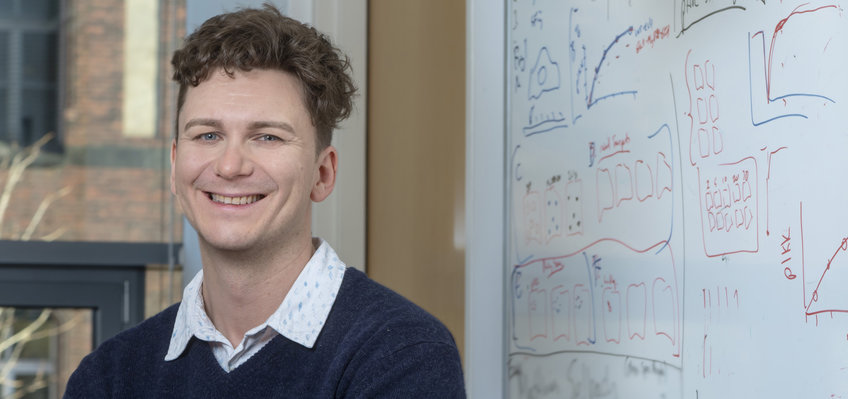
Open to questions, especially good ones
Portrait Marcus Taylor
Marcus Taylor studies communication. To be more precise, he studies the communication between the cells in our immune system. The most important tool in this work is an ultramodern high-resolution microscope. Taylor switches on the microscope to show us how he listens in on cellular conversations. Computers hum into action and after a while the monitors light up. They show images from another world. Small white, red and green dots flicker over the screen and we perceive a mysterious crackling.
Taylor points at a group of green dots by way of explanation. “That is a cluster of signal molecules inside an immune system cell. Each dot is one molecule. When the concentration of molecules in this area of the cell exceeds a certain value it triggers a signal. For example, the immune cell then releases a transmitter substance that attracts other immune cells. Or the cell goes into action and kills pathogens.“
In Taylor’s research the central question is just how immune cells communicate at the molecular level. How do they sense the information contained in the transmitter substances released by other cells? How do they process the information and how do they pass it on? To get some answers Taylor has been working since the end of 2017 to establish his “Visualisation of Immune Signalling” lab at the Max Planck Institute for Infection Biology (MPIIB) in Berlin.
Born in Australia, Taylor had already spent time studying and researching in England, the USA and India before coming to Berlin. “I originally studied biochemistry,” says Taylor, “but each time I moved somewhere new I came into contact with a new research direction, and that had a major influence on my own work and where it was headed.“
So on top of the biochemistry he found himself learning biology, computer science, engineering or physics as well. “The time I spent in India was especially exciting,” says Taylor, a lanky Australian in his mid-thirties, “That was where I was exposed to theoretical physics.” Just how does theoretical physics fit in with biology? Taylor explains: “I was interested in how the cells make sure they are really passing on the right information correctly. There are old concepts in theoretical physics that deal with this very problem of quality assurance in information transmission. I applied these concepts to the communication of the immune cells – and I learnt a whole lot.“
Biochemist Taylor adopted a completely new way of thinking to achieve this, as he tells us: “At the beginning I had to find some common ground with the theoretical physicists so that I could discuss ideas with them. Once that had happened it was incredibly enriching. It helps me to think much more conceptually and formulate research questions more clearly.“
It was also the good research questions that most impressed Taylor, along with the excellent equipment, when he went for his interviews at the MPI. “It was clear to me straight away that I’d find colleagues here who I’d be able to have really fruitful discussions with. The kind of people who ask questions that drive research forward throughout the Institute.” Another argument in favour of Berlin was that the Max Planck Society was prepared to invest half a million euros in buying a high-resolution microscope, a so called “total internal reflection microscope”. “Of course, the fact that I can use it to observe individual molecules as they communicate is incredibly helpful to my research,” says Taylor.
And so the move was made. In 2017 the globe-trotting researcher moved to Berlin with his wife, his three children and all their things. “We got off to a really good start here. This city makes it easy to arrive and the kids are just soaking up the German language. Not like me. It really is child’s play for them.“
But language learning is not Taylor’s main concern at the moment. He wants to enlarge his team so interviews are item number one on his agenda. “At the moment I’m trying to find more good people to work in the lab. Young scientists who can be inspired by my topic – the visualisation of signals in the immune system.” And how will you know who to choose, Marcus? “If they ask good questions. Good questions drive things forward.“
Hannes Schlender